Kamień jako świadek historii
For a very long historical period the Polish society had lived in an isolated centre of Europe which was divided ideologically, economically and intel
Author(s): Marcin ZaborskiSubject(s): Social Sciences
Published by: Towarzystwo Naukowe Franciszka Salezego (TNFS)
Summary/Abstract: The article aims at answering the following questions: What did stones symbolize in different cultures, centuries and civilizations? What importance did they have in the past? How does it influ- ence the culture of memory? Stone has been considered a mythological symbol of power. In modern language it is a tradi- tional symbol of strength and wisdom. Therefore, stone is a symbol of the eternity. The relative permanence of stones can help us recognize the inner self that is beyond the cycle of life and death, and is eternal. Throughout the history the cult of stones has taken different forms. The stone has been per- ceived as a magical touchstone. The Kingdom of God is symbolized by the stone, by the mountain. In the Bible we read about Jacob who placed a stone under his head before he went to sleep and saw a ladder that was stretched between Earth and Heaven. In Mecca, in the house of God there is a black stone which is in fact a meteor. In the Islamic tradition, this stone which fell from heaven, symbolizes the original covenant made between man and God. The article describes those images and analytically presents the connection between the history of stone and the social culture of memory. The author refers to various monuments and places of memory, and asks – what symbol can we see in those places? What was the role of stone in them? What did the stone symbolize?
Journal: Seminare. Poszukiwania naukowe
- Issue Year: 23/2006
- Issue No: 1
- Page Range: 305-318
- Page Count: 14

